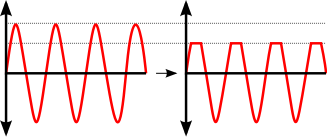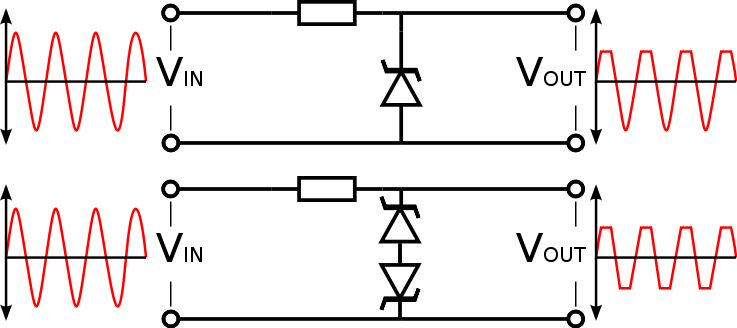- Clipper (electronics)
-
In electronics, a clipper is a device designed to prevent the output of a circuit from exceeding a predetermined voltage level without distorting the remaining part of the applied waveform.
A clipping circuit consists of linear elements like resistors and non-linear elements like junction diodes or transistors, but it does not contain energy-storage elements like capacitors. Clipping circuits are used to select for purposes of transmission, that part of a signal wave form which lies above or below a certain reference voltage level.
Thus a clipper circuit can remove certain portions of an arbitrary waveform near the positive or negative peaks. Clipping may be achieved either at one level or two levels. Usually under the section of clipping, there is a change brought about in the wave shape of the signal.
Clipping Circuits are also called as Slicers, amplitude selectors or limiters. Using square waveform it is easier to analyze the clipper network than sinusoidal waveform,because in square waveform only two level (i.e.two DC level) have to be considered.
Contents
Types
Zener Diode
In the example circuits above, one or two zener diodes are used to clip the voltage VIN. In the first circuit, the voltage is clipped to the reverse breakdown voltage of the zener diode. The output voltage in the first circuit should also never be more negative than the diode's forward voltage (such as .7V for a typical diode), but it is not shown in the picture. In the second, the voltage in either direction is limited to the reverse breakdown voltage plus the voltage drop across one zener diode.
Application
Clippers are used in rectification process,that is to convert ac to dc. clippers are also used in wave shaping. It is used in television sets and FM receivers. It is also used for amplifiers and different types of op-amps through which it is possible to perform mathematical operations. Diode clipper can be used for the protection of different types of circuit. For example :a digital circuit against transients which may cause considerable damage.
Classification
Clippers may be classified into two types based on the positioning of the diode. [1]
- Series Clippers, where the diode is in series with the load resistance, and
- Shunt Clippers, where the diode in shunted across the load resistance.
The diode capacitance affects the operation of the clipper at high frequency and influences the choice between the above two types. High frequency signals are attenuated in the shunt clipper as the diode capacitance provides an alternative path to output current. In the series clipper, clipping effectiveness is reduced for the same reason as the high frequency current passes through without being sufficiently blocked.
Clippers may be classified based on the orientation(s) of the diode. The orientation decides which half cycle is affected by the clipping action. Depending of feature of diode,the positive or negative region of the input signal is "clipped" off & accordingly the diode clipper can be classified as:
- Positive Diode Clipper, the positive half cycle of the input will be removed.
- Negative Diode Clipper, the negative half cycle of the input will be removed.
The clipping action can be made to happen at an arbitrary level by using a biasing elements (potential sources) in series with the diode.
- Positively Biased Diode Clipper
- Negatively Biased Diode Clipper
The signal can be clipped to between two levels by using both types of diode clippers in combination. [2] This clipper is referred to as
- Combinational Diode Clipper or Two-Level Clippers
The clamping network is the one that will "clamp" a signal to a different dc level. The network must have capacitor, a diode, and a resistive element, but it also employs an independent dc supply to introduce an additional shift.
References
- ^ Salivahanan, Electronic devices and circuits. 2nd Edition. Tata McGraw Hill, 2008, Page 555, ISBN 0-07-066049-2
- ^ Rao K Venkata, Pulse And Digital Circuits, Pearson, 2010, page 163, ISBN 978-81-317-2135-3
- Robert L. Boylestad, Electronic devices and circuit Theory. 8th Edition. Eastern Economy Edition, 2002, Page 83, ISBN-81-203-2064-6
- An overview of Clipping Circuits, Circuits Today
See also
- Clamper (electronics)
- Clipping (signal processing)
- Orifice plate which can function as a mechanical clipper for acoustic signals.
Categories:- Electronic circuits
Wikimedia Foundation. 2010.


